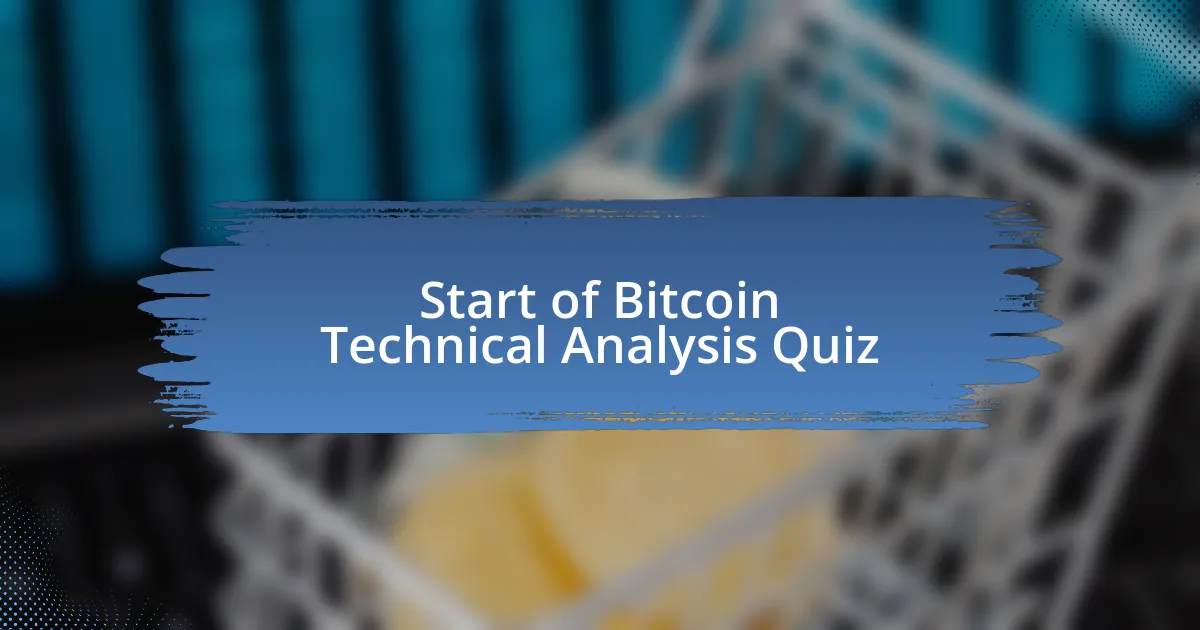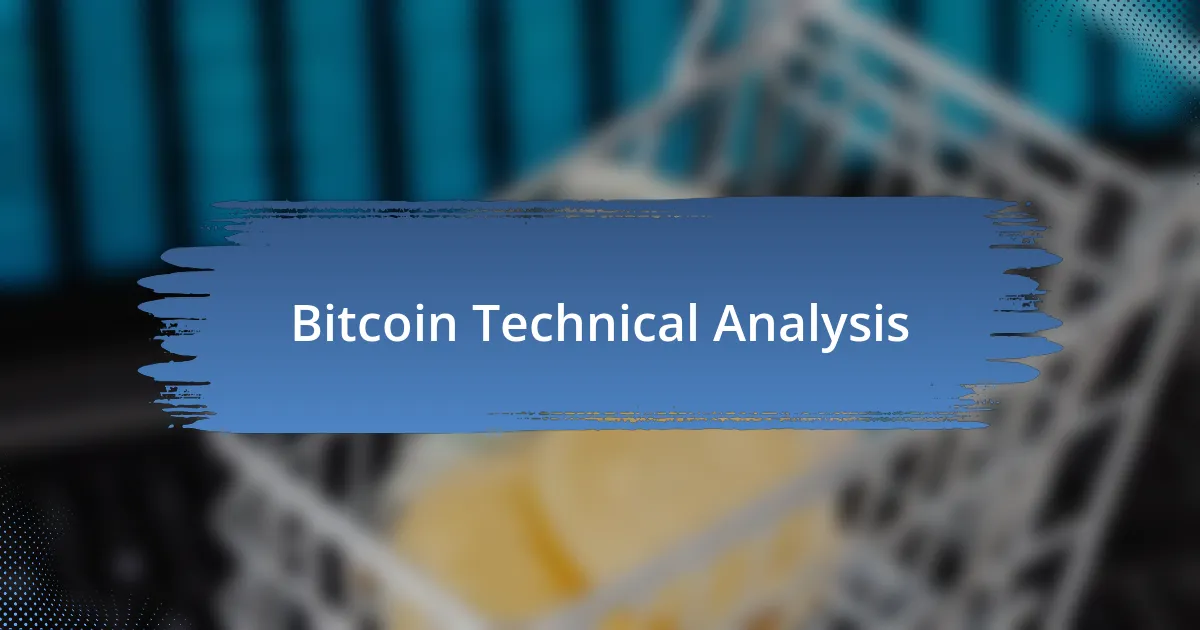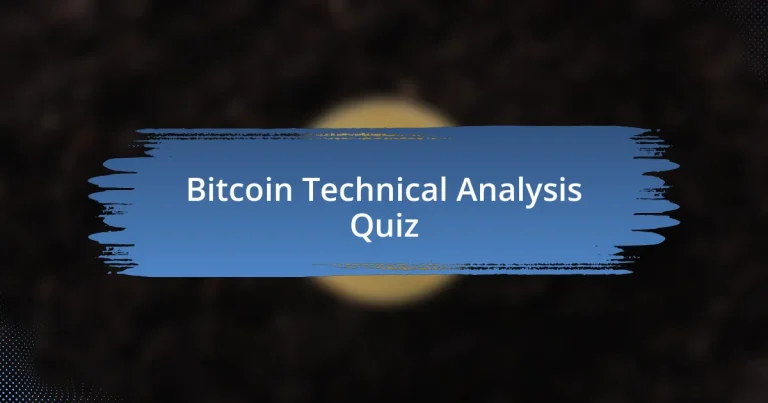
Start of Bitcoin Technical Analysis Quiz
1. What is the primary function of miners in the Bitcoin network?
- Miners create new cryptocurrencies through trading.
- Miners store Bitcoin wallets for users.
- Miners build hardware for Bitcoin exchanges.
- Miners validate transactions and solve complex mathematical problems to add new blocks to the blockchain.
2. What is the term for the process of solving a difficult math problem to validate a new block of transactions?
- Proof-of-work
- Block confirmation
- Transaction verification
- Encryption process
3. What is the name of the algorithm used by Bitcoin for its proof-of-work?
- SHA-256
- RSA
- MD5
- AES-128
4. What is the term for the empty value in each block that is filled by the miner of that block?
- Fee
- Nonce
- Block
- Hash
5. How often, on average, can we expect a new block to be found by miners?
- Every hour
- Every 30 minutes
- Every 10 minutes
- Every 5 minutes
6. What is the term for a measure of how difficult it is to find a hash below the target?
- Blocktime
- Hashrate
- Target
- Difficulty
7. What is the term for a technology to verify wallets by requiring multiple signatures to process a single transaction with enhanced security?
- Wallet safety check
- Transaction key sign
- Secure authorization
- Multi-sig verification
8. What is the term for a backwards incompatible protocol change that makes previously invalid blocks or transactions valid?
- Difficulty change
- Hard fork
- Block reward
- Soft fork
9. What is the term for a backwards compatible protocol change that makes previously valid blocks or transactions invalid?
- Hard fork
- Soft fork
- Data fork
- Code fork
10. What is the term for a set of rules that miners and nodes must follow?
- Network guidelines
- Consensus rules
- Mining protocol
- Blockchain standard
11. What is the term for a chart pattern that suggests buyers are more aggressive than sellers?
- Ascending triangle
- Descending triangle
- Cup and Handle pattern
- Head-and-shoulders pattern
12. What is the term for a chart pattern that suggests sellers are in control?
- Ascending wedge
- Descending triangle
- Bullish flag
- Rectangle pattern
13. What is the term for a chart pattern that typically appears in downtrends and often signals bullish reversals?
- Ascending triangle
- Head-and-shoulders pattern
- Descending wedge
- Cup and Handle pattern
14. What is the term for a chart pattern that often signals a bullish continuation in price?
- Cup and Handle pattern
- Ascending triangle
- Double Bottom pattern
- Descending wedge
15. What is the term for a chart pattern that is crucial for identifying bearish reversals in crypto trading?
- Ascending triangle
- Cup and handle pattern
- Double bottom pattern
- Head-and-shoulders pattern
16. What is the term for a technical analysis tool that involves drawing lines at key percentages between two points on a price chart?
- Trend channels
- Fibonacci retracement levels
- Moving averages
- Bollinger bands
17. What is the significance of the 61.8% Fibonacci Level in Bitcoin price stabilization?
- It is a barrier that prevents any upward movement.
- It represents the average price over the last year.
- It is a strong support area based on Fibonacci theory.
- It indicates a market bubble ready to burst.
18. What is the term for a trend line that connects a series of price lows, indicating potential support?
- Price foot line
- Support trend line
- Trend anchor line
- Resistance chart line
19. What is the term for a trend line that connects a series of price highs, indicating potential resistance?
- Support trend line
- Price corridor
- Trend channel
- Resistance trend line
20. What is the term for a moving average that smooths out price data over a longer period, often used to identify trends?
- Weighted moving average (WMA)
- Simple moving average (SMA)
- Cumulative moving average (CMA)
- Exponential moving average (EMA)
21. What is the term for a moving average that gives more weight to recent price data, often used to identify short-term trends?
- Moving average convergence divergence (MACD)
- Simple moving average (SMA)
- Weighted moving average (WMA)
- Exponential moving average (EMA)
22. What is the term for a technical indicator that measures the speed and change of price movements, often used to identify overbought or oversold conditions?
- Relative Strength Index (RSI)
- Moving Average Convergence Divergence (MACD)
- Bollinger Bands
- Average True Range (ATR)
23. What is the term for a technical indicator that measures the difference between the closing price and a moving average, often used to identify crossovers?
- Simple Moving Average (SMA)
- Relative Strength Indicator (RSI)
- Moving Average Convergence Divergence (MACD)
- Exponential Moving Average (EMA)
24. What is the term for a chart pattern that consists of two peaks at about the same height, indicating a potential trend reversal?
- Double Top pattern
- Ascending triangle
- Double Bottom pattern
- Head-and-shoulders pattern
25. What is the term for a chart pattern that consists of two troughs at about the same depth, indicating a potential trend reversal?
- Cup and Handle pattern
- Double Top pattern
- Ascending Triangle
- Double Bottom pattern
26. What is the term for a technical analysis tool that helps identify potential support and resistance levels by drawing lines at key price levels?
- Chart patterns
- Moving averages
- Trend lines
- Support and resistance levels
27. What is the term for a technical analysis tool that helps identify potential trend reversals by measuring the speed and change of price movements?
- Fibonacci levels
- MACD
- Support levels
- RSI
28. What is the term for a technical analysis tool that helps identify potential trend reversals by measuring the difference between the closing price and a moving average?
- RSI
- MACD
- EMA
- SMA
29. What is the term for a technical analysis tool that helps identify potential trend reversals by drawing lines at key price levels?
- Trend lines
- Moving averages
- Support zones
- Candlestick charts
30. What is the term for a technical analysis indicator that signals potential market trends based on volume and price movements?
- Relative Strength Indicator
- Simple Moving Average
- Moving Average Convergence Divergence (MACD)
- Trend line

Congratulations, You’ve Completed the Bitcoin Technical Analysis Quiz!
Thank you for participating in our Bitcoin Technical Analysis quiz! We hope you found the questions intriguing and informative. Engaging in this quiz is a valuable way to sharpen your understanding of key concepts. You likely learned about chart patterns, indicators, and how to interpret market trends. Each question was designed to challenge your knowledge and expand your critical thinking skills.
The process of answering quiz questions helps reinforce what you’ve learned. It allows you to identify areas where you are strong and where you might want to dive deeper. By exploring these concepts, you can become more confident in your ability to analyze Bitcoin’s market movements. This knowledge is essential for anyone looking to navigate the ever-evolving world of cryptocurrency.
If you found this quiz helpful, we invite you to explore the next section on this page. There, you’ll discover in-depth information about Bitcoin Technical Analysis. This resource will provide you with further insights and strategies that can enhance your trading skills. Take the next step in your learning journey, and continue to grow your understanding of Bitcoin!

Bitcoin Technical Analysis
Introduction to Bitcoin Technical Analysis
Bitcoin technical analysis is the study of historical price movements of Bitcoin to forecast future price actions. Investors and traders use various tools and techniques to identify patterns and trends in the market. This form of analysis relies heavily on charts and indicators like moving averages and volume to make informed decisions. The goal is to predict price fluctuations to optimize entry and exit points in trading.
Key Indicators Used in Bitcoin Technical Analysis
Several key indicators enhance the effectiveness of Bitcoin technical analysis. Common indicators include the Relative Strength Index (RSI), Moving Average Convergence Divergence (MACD), and Bollinger Bands. Each of these tools provides insights into price momentum, market trends, and potential breakout or reversal points. Their signals help traders identify overbought or oversold conditions, facilitating better execution of trades.
Chart Patterns in Bitcoin Technical Analysis
Chart patterns are formations created by the price movements of Bitcoin on charts. Patterns like head and shoulders, double tops and bottoms, and triangles indicate potential trend reversals or continuations. Recognizing these patterns allows traders to anticipate future price movements based on historical behavior. The reliability of these patterns can significantly influence trading strategies and risk management.
The Role of Support and Resistance Levels
Support and resistance levels are critical components of Bitcoin technical analysis. Support is the price level at which demand is strong enough to prevent the price from falling further. Resistance, on the other hand, is where selling pressure prevents the price from rising. These levels help traders determine potential entry and exit points, as well as setting stop-loss orders to manage risk in volatile markets.
High-Frequency Trading and Bitcoin Technical Analysis
High-frequency trading (HFT) in Bitcoin involves using algorithms and high-speed networks to execute trading strategies at rapid rates. HFT relies on technical analysis to identify short-term price fluctuations across various exchanges. This approach capitalizes on market inefficiencies, allowing traders to make profits from small price changes. HFT necessitates a deep understanding of technical indicators to remain competitive in fast-paced trading environments.
What is Bitcoin Technical Analysis?
Bitcoin Technical Analysis (TA) is the study of historical price movements and trading volumes of Bitcoin to forecast future price trends. It uses various tools and indicators, such as moving averages, RSI, and Fibonacci retracements, to identify patterns. Historical data shows that 70% of traders rely on these methods to make informed trading decisions.
How is Bitcoin Technical Analysis performed?
Bitcoin Technical Analysis is performed by charting price data, identifying trends, and applying various indicators to interpret market behavior. Traders often utilize software platforms like TradingView for real-time analysis. According to a 2021 survey, approximately 40% of traders assert that TA has improved their trading outcomes significantly.
Where can Bitcoin Technical Analysis be applied?
Bitcoin Technical Analysis can be applied to various trading platforms, including centralized exchanges like Binance and decentralized platforms like Uniswap. It is also relevant in crypto analysis websites, enabling traders to assess price movements efficiently. As of 2022, over 60% of crypto trading occurred on centralized exchanges, indicating wide applicability of TA in those environments.
When should Bitcoin Technical Analysis be used?
Bitcoin Technical Analysis should be used when traders want to make short- to medium-term trading decisions based on price movements and market sentiment. It is most effective during significant market events, such as halving or major regulatory news, which historically cause price volatility. Research indicates that 80% of significant price changes occur post-event announcements.
Who uses Bitcoin Technical Analysis?
Bitcoin Technical Analysis is used by traders, investors, and financial analysts interested in Bitcoin and cryptocurrency markets. Retail traders, institutional investors, and hedge funds all employ TA to make data-driven decisions. In 2023, it was reported that institutional investment in Bitcoin surged, driving the need for advanced trading strategies like TA.


